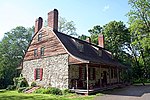Beacon station

Beacon station is a commuter rail stop on the Metro-North Railroad's Hudson Line, serving Beacon, New York. The station is heavily used by residents of Orange and Dutchess Counties who drive to the station. It is a wheelchair accessible station, featuring wheelchair ramps, an elevator to the train platform, and a high-level island platform which is level with the doors on the train (for many years, most Upper Hudson Line stations had platforms that were lower than the train doors). It also boasts a small newsstand on the platform itself, open daily. It is not fully ADA accessible. Paid parking is provided. There are spaces that require permits and others which can be paid for on a daily basis. Parking is free on weekends and holidays. Recent renovations by the Metropolitan Transportation Authority reflect the station's increasing traffic and importance as a destination. The Dia Beacon art museum, a short walk from the station, has drawn regular visitors from the city since its 2003 opening to see its collection of large installations which could not be shown in the more limited spaces available in Manhattan. Many signs in and around the station point the way. The heavy Dia traffic on weekends is complemented by visitors to prisoners at Fishkill or Downstate correctional facilities, who take many of the taxis available from the station to the prisons just outside town. The station complex also has long housed an upper Hudson Line station of the MTA Police.
Excerpt from the Wikipedia article Beacon station (License: CC BY-SA 3.0, Authors, Images).Beacon station
West Main Street,
Geographical coordinates (GPS) Address Nearby Places Show on map
Geographical coordinates (GPS)
| Latitude | Longitude |
|---|---|
| N 41.5064 ° | E -73.9848 ° |
Address
West Main Street 31
12508
New York, United States
Open on Google Maps


